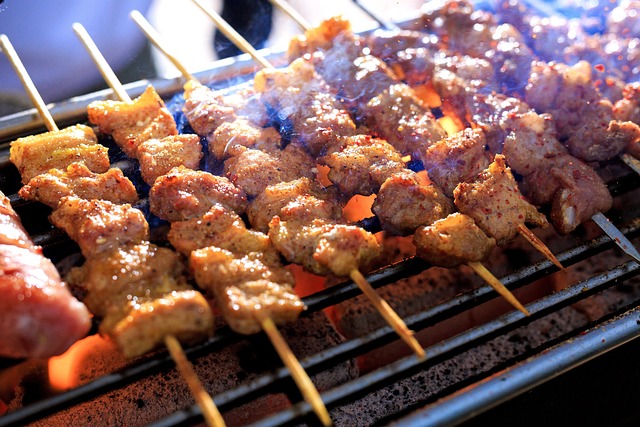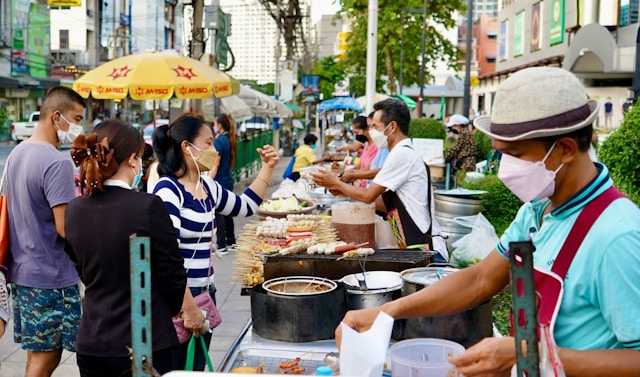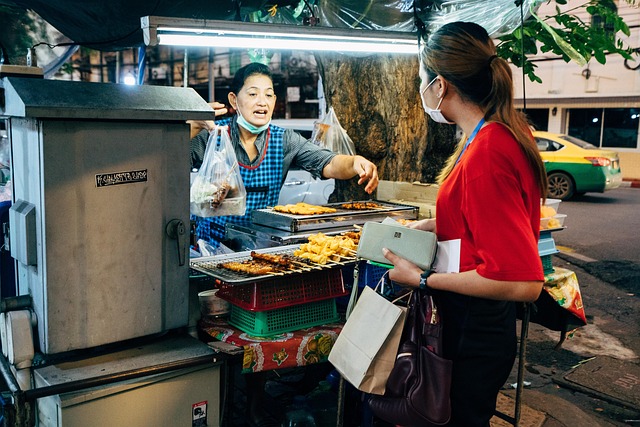One of the first things that hits you in Thailand isn’t the heat — it’s the scent. Wander through any market or busy street, and you’re sure to catch the smoky perfume of grilled meats, sweet coconut batter sizzling on cast-iron pans, or crispy delights being fried to golden perfection. In the Land of Smiles, food is everywhere, and snacks are a national obsession. Here’s our handpicked list of 10 Thai street snacks you should absolutely taste on your journey.
A Flavor Explosion at Every Street Corner
Thai street food is cheap, fast, and full of flavor. You’ll find it everywhere: night markets, food courts, lively sidewalks, and even in front of schools. Whether sweet or savory, these local bites offer an authentic taste of Thai culture.
Top 10 Must-Try Thai Street Snacks
Sweet or Savory? Quick Snack Comparison
| Sweet Snacks | Savory Snacks |
|---|---|
| Kanom Krok (Coconut pancakes) | Moo Ping (Grilled pork skewers) |
| Khanom Buang (Crispy crepes) | Sai Krok Isan (Fermented sausage) |
| Khao Lam (Coconut sticky rice in bamboo) | Gai Tod (Fried chicken) |
| Patongo (Sweet dough sticks) | Tod Man Pla (Spicy fish cakes) |
Whether you’ve got a sweet tooth or crave something savory, Thai street food has something to satisfy every craving!
1. Moo Ping (หมูปิ้ง)

These sweet-salty pork skewers are marinated overnight and grilled on smoky charcoal until juicy and caramelized. Often eaten with sticky rice, Moo Ping is a morning favorite, but locals grab it any time hunger strikes.
2. Kanom Krok (ขนมครก)
Bite-sized and rich with coconut flavor, these soft-centered, crispy-edged treats are made by pouring batter into a bubbling cast-iron pan. Some versions include sweet corn or chopped green onions for contrast.
Curious about how coconut shapes Thai snacks, drinks, and daily life? Explore our coconut guide for cultural insights, recipes, and delicious facts.
3. Sai Krok Isan (ไส้กรอกอีสาน)
Fermented pork and sticky rice sausage from Northeast Thailand, with a tangy and unique flavor. Best enjoyed with fresh chilies and raw cabbage.
4. Khao Jee (ข้าวจี่)
A rustic snack from Isan: sticky rice patties dipped in beaten egg and grilled over charcoal. Crispy on the outside, soft on the inside—often enjoyed hot in morning markets.
5. Roti (โรตี)
Thin Indian-style pancakes cooked on a hot plate, commonly filled with banana, sweetened condensed milk, or eggs. A sugary delight for kids and adults alike.
6. Patongo (ปาท่องโก๋)
Golden, X-shaped deep-fried dough sticks. Typically served at breakfast and dipped in condensed milk or strong Thai coffee.
7. Gai Tod (ไก่ทอด)
Thai-style fried chicken—crispy, juicy, and often paired with sticky rice and sweet chili sauce.
8. Tod Man Pla (ทอดมันปลา)
Spicy Thai fish cakes infused with red curry paste and lemongrass. Served hot with sweet and tangy peanut dipping sauce.
9. Luk Chin (ลูกชิ้น)
Found near schools and bus stops, these skewered meatballs (fish, pork, or beef) are grilled or steamed, then dunked in a tangy chili sauce. Simple, filling, and addictive, they’re a favorite for kids and grownups alike.
10. Khanom Buang (ขนมเบื้อง)
Delicate crispy crepes topped with sweet meringue and candied egg yolk threads or shredded coconut. Light and crispy in every bite.
Khao Lam (ข้าวหลาม)
Sticky rice cooked with coconut milk and black beans inside a bamboo tube. Slowly roasted over open fire, it takes on a smoky aroma and creamy texture—an ideal edible souvenir.
Grilled or Steamed Corn (ข้าวโพด)
Whole or shelled corn, grilled over coals or steamed, served with salty or sweet butter. A simple yet satisfying snack found nationwide.
Regional Specialties Worth Discovering

Many snacks are regional gems: Sai Krok Isan is from the northeastern provinces, while sweet roti is more popular in the predominantly Muslim South. As you travel across Thailand, you’ll experience a fascinating regional diversity in street cuisine.
What About the Street Food Classics?
Well-known dishes like Pad Thai, Som Tam (green papaya salad), or Mango Sticky Rice are more considered meals than snacks. Learn more in our full Pad Thai feature article.
However, many of these dishes can be enjoyed on the go: Pad Thai in takeaway boxes, Som Tam served in plastic bags with a spoon, or Khao Man Gai (chicken with rice) as a quick lunch. In Thai street food, the line between a snack and a meal is often blurry.
A Street Food Experience That Changes by Region and Season
In the North (Chiang Rai, Mae Hong Son), you’ll find snacks with Burmese and Lao influences like Shan noodle soups. In the South, snacks are spicier and seafood-based. During the cool season (November to February), more fried and hot snacks appear at markets, while in the hot season, icy desserts and fresh fruits are favored.
Snacks, Health & Sustainability: What to Know
Travelers are increasingly mindful of what they eat. Many street vendors prepare food fresh daily with local ingredients. Look for “OTOP” labels (One Tambon One Product), which identify traditional products supported by the Thai government.
For a healthier experience, favor grilled or steamed snacks and avoid items left exposed too long. In cities like Bangkok (Ari, Thonglor) or Chiang Mai, you’ll also find vegan or organic options among street stalls and local markets.
What Tourists Say About Thai Street Food
“We didn’t expect so much variety. Everything was tasty, cheap, and it felt like a real connection with the locals!” — Claire & Hugo, French travelers in Chiang Mai
For many visitors, street food in Thailand is about value, culture, and human connection. Eating in the street is not just about food—it’s about sharing smiles, stories, and discovery.
Most Popular Thai Street Snacks Among Tourists
- Moo Ping – Loved for its smoky-sweet flavor and soft texture
- Roti with banana – A hit among kids and dessert lovers
- Patongo – Perfect for breakfast with Thai coffee
- Kanom Krok – Instagrammable and delicious
- Mango Sticky Rice – Technically a dish, but too iconic not to mention
These snacks are easy to find, tourist-friendly, and guaranteed to impress even picky eaters!
Vegetarian, Vegan, Halal or Kosher? No Problem
Looking for halal snacks? Head south—Hat Yai and Yala have many options. In Bangkok, try neighborhoods like Ramkhamhaeng or Nana. Vegan options (ask for “kin jay” กินเจ) are common in Chiang Mai and tourist areas. With a bit of vocabulary and a smile, you’ll find food for every lifestyle.
How Much Do Thai Snacks Cost?
Good news: Thai snacks are incredibly affordable! Expect to pay around 10 to 30 baht for simple items, and up to 40 to 50 baht in touristy areas or for larger portions. With prices this low, why not try them all?
Where to Find the Best Street Snacks in Thailand

Look for night markets, busy intersections, and roadside food stalls. Bangkok, Chiang Mai, Phuket, and Pattaya are street food heavens. In Bangkok, check out Yaowarat (Chinatown) and Ratchada Rot Fai Market. In Chiang Mai, try the Sunday Night Market or Warorot Market. Follow the crowd—and your nose!
Tips for Trying Thai Snacks Safely
- Choose stalls with lots of local customers—they’re usually fresher.
- Avoid food left uncovered if you’re sensitive.
- Opt for snacks cooked in front of you and served hot.
How to Pay for Street Snacks in Thailand
Most vendors accept cash only, so keep small bills (20–100 baht) handy. In cities and modern markets, paying by QR code using Thai banking apps (KBank, SCB, Krungthai…) is increasingly common. If you have a Thai account, just scan and pay.
Want to feel more confident when buying snacks in Thai? Check out our practical guide on how to order food in Thailand, with local phrases, apps, and tips to make things easy.
Want to Cook Thai Snacks at Home?
You’ll find plenty of recipes on YouTube or in Thai cookbooks. A good starting point: Kanom Krok and Moo Ping. We recommend Pailin’s Kitchen for easy, authentic tutorials.
Snacks to Bring Home? Try These Packaged Delights
Many Thai snacks are packaged for travel: banana chips, tamarind candies, puffed rice snacks, and more. Delicious edible souvenirs you’ll want to bring back!
Pair Your Snack with a Must-Try Thai Drink
Snacks go even better with a local drink! Try Cha Yen (Thai iced tea with condensed milk), Nam Manao (fresh limeade), or blended fruit juices served over crushed ice. Refreshing, cheap, and everywhere!
Thai Street Food Glossary: Know What You’re Ordering
Not sure what some snack names mean? Here’s a quick guide to common Thai food terms you’ll see on signs and menus:
- Moo (หมู) – Pork
- Gai (ไก่) – Chicken
- Ping (ปิ้ง) – Grilled over charcoal
- Tod (ทอด) – Deep-fried
- Khao (ข้าว) – Rice
- Khao Niao (ข้าวเหนียว) – Sticky rice
- Kanom (ขนม) – Snack or sweet treat
- Buang (เบื้อง) – Thin, crispy (as in crepes)
- Lam (หลาม) – Cooked in bamboo
- Sai Krok (ไส้กรอก) – Sausage
With just a few words, you’ll read street signs like a local and order with confidence!
Conclusion: Thailand, One Bite at a Time

Thai street food isn’t just about filling your belly — it’s a cultural ritual, a sensory adventure, and a daily joy shared across generations. Whether you’re tasting something spicy, sweet, or completely unexpected, every snack tells a story. So go ahead: follow your nose, explore with your taste buds, and don’t forget to say “Aroy mak!” – it means “delicious!”
